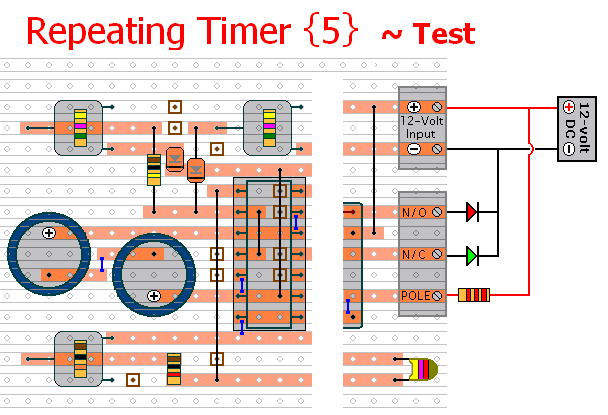This repeating timer can be adjusted to work only when it's hot. It lets you set the level of temperature at which it will start to run. The length of time the outputs last - and the length of the intervals in between - are also adjustable.

Do not use the "on-board" relay to switch mains voltage. The board's layout does not offer sufficient isolation between the relay contacts and the low-voltage components. If you want to switch mains voltage - mount a suitably rated relay somewhere safe - Away From The Board.
Introduction
The prototype of the Repeating Timer No5 was built using only the Stripboard Layout as a guide. So - if you have faithfully reproduced that layout - you will have a working circuit.
Once you're satisfied that your layout is correct - and you have made a careful and thorough check of the underside of the board - it's time to power-up the circuit and test its operation. This is always an anxious moment. If you construct a lot of circuits - you might consider building the
Current Limiting Power Supply - or alternatively - you could add the Simple Current Limiter to your existing PSU. Both will let you set an upper limit on the amount of current supplied to your circuit - and so protect it from any serious damage.
Setup
Click Here For A Photograph Of The Prototype
Sample Readings
The following readings will give you some idea of what to expect. They are taken from the prototype. They apply to the Cmos 4011. And they were made using a cheap digital multimeter and a cheap thermometer. They are intended for guidance only. You should NOT expect to get identical readings.
My thermistor measured 4.45K at 25ºC (77ºF). My supply voltage measured 12v4. And the Pin 1 switching point was measured at just over 6v9. With R7 set to 5k - the timer worked at temperatures above about 21.5ºC (71ºF).
If You Find a Problem
If - in the course of the test - you find that something is not working properly - then a careful inspection of the relevant area of the circuit board should turn up the cause of the problem. Where you've cut the board to size - look for small loose strands of copper left behind by the saw. Check the board for short-circuits caused by component leads touching each other. If an LED is not lighting - check that it's connected the right way round. It can also happen that the stripboard itself is faulty. I have seen cases where the copper tracks have not been completely severed from one another during manufacture.
If you've built your circuit using the specified components - and you've followed the step-by-step construction guide described on the Repeating Timer No.5 - Support Page - then the chances are that any bug will be caused by something minor - a component connected the wrong way round - a missing or unwanted solder bridge - an incomplete cut in the track etc.
If you can't see anything obvious then adopt a systematic approach to faultfinding. Begin by double-checking that all of the cuts in the tracks have been made, that they are all - In The Right Place - and that they sever the track completely. Use a magnifying glass. It only takes the smallest strand of copper to cause a problem. If you backlight the board during the examination - it makes them easier to spot.
When you're satisfied that the tracks have been severed in all the right places, check that you have made - and correctly placed - all of the solder bridges. Mark each bridge with a felt-tip pen - or something similar - so that it can be easily identified later.
Next - carefully examine the full length of each track. Look for unwanted solder bridges. Your felt-tip markings will tell you which ones should be there - and help you identify any that shouldn't be there. Again, if you backlight the board during the examination - it makes potential problem areas easier to spot.
If all else fails and you still haven't found the cause of the problem - work your way through the assembly instructions on the Support Page. Check each individual component and link - to make sure that it's present and correctly positioned.
Print out the drawings and mark off the components as you go. Pay particular attention to the orientation of the diodes, the transistor and electrolytic capacitors. Take your time and examine each individual component carefully.
 SUGGESTIONS
SUGGESTIONS


